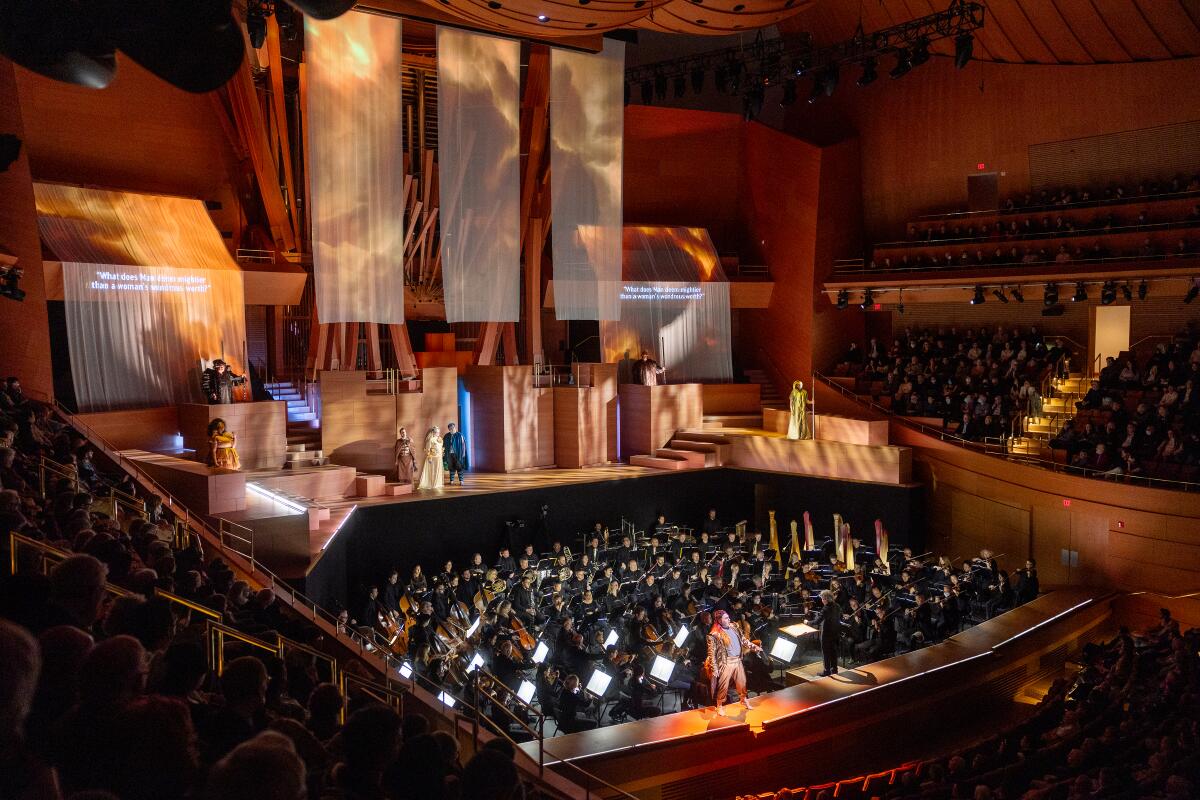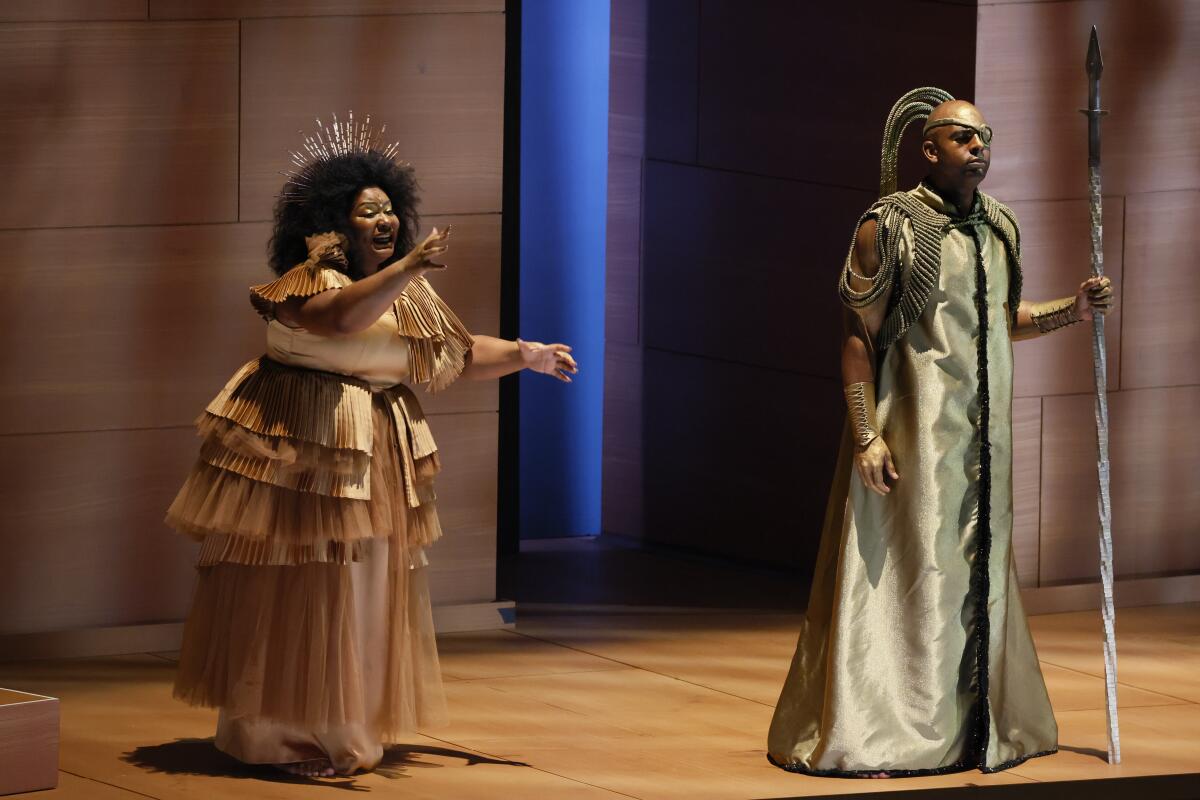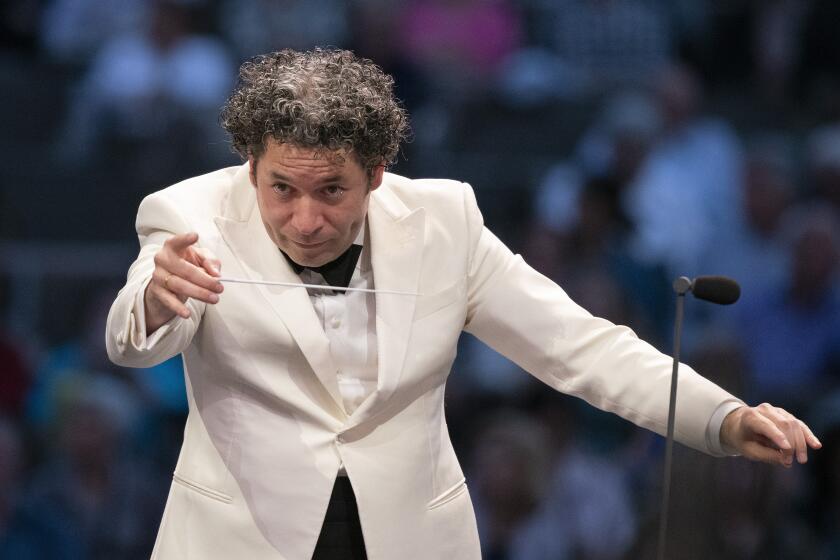How Gustavo Dudamel, the L.A. Phil and Frank Gehry pulled off a very L.A. ‘Das Rheingold’

- Share via
Los Angeles has little history with Wagner’s four-opera “Ring” cycle, his epic on how to save the world from conniving gods, power mongers and hoarders of wealth with their ruinous fancies. This global predicament is never out of date. The 2010 L.A. Opera production has been the only full cycle in L.A. since 1930. In this country, San Francisco, New York, Chicago and Seattle have seen several.
But after the Los Angeles Philharmonic mounted “Das Rheingold” last weekend — the two-and-a-half-hour prologue to the three main “Ring” operas — it should be safe to say that there is such a thing as an L.A. “Ring.” Gustavo Dudamel conducted. Frank Gehry created sets, turning his Walt Disney Concert Hall into a site-specific Valhalla, the gods’ mega-mansion. The production by Venezuelan film director Alberto Arvelo had a kind of superhero Hollywood feel to it. Globally it may be the “Ring” we need in this era of tech wannabe gods and capricious autocrats.
Compared with contemporary “Ring” productions, particularly in Europe, where Wagner’s warning is often treated as a compellingly dysfunctional family drama, this might seem old-school conventional. But showing the gods to be like you and me can diminish Wagner’s scope. In L.A., bizarre gods have tended to operate more in realms of grand fantasy. It’s not the power of specific individuals that need scare us but power, period.
Such was the L.A. Opera case when German director and visual artist Achim Freyer dressed Wagner’s characters in whimsically surreal costumes and placed them somewhere beyond our known realm. The L.A. Phil’s other recent foray into the “Ring” was the third act of the second of the cycle’s operas, “Die Walküre,” staged at the Hollywood Bowl the summer before last. Fabulist L.A. director Yuval Sharon turned the Bowl into a digital video wonderland with novel live animation that transformed singers into startling digital avatars.
The novelty of the L.A. Phil “Rheingold” was architectural rather than technological. Gehry didn’t so much as build a set for the Disney stage as make his 20-year-old concert hall itself the set. For a pit, the architect lowered the stage a few feet, as far as it could go. Behind it he built boxy structures out of the same light-colored Douglas fir he used for the hall’s walls (which have darkened slightly with age).
He hung elegant, transparent grayish fabric drapes on which modest scenic projections occasionally appeared along with supertitles. Although most of the action took place at a dimly lighted distance from the audience, behind the orchestra and among Gehry’s boxes, a narrow Douglas fir lip in front of the orchestra did provide a place for singers. Loge, the god of fire, used that as an opportunity to playfully pretend to conduct and whisper in Dudamel’s ear.
The weirdness this time came from Cindy Figueroa’s fancifully colorful costumes. The god of fire glowed in a silvery outfit. King of the gods, Wotan, sported dashing futuristic tribal dress. His wife, Fricka, wore an elaborately designed, flowing, full skirt that stood in contrast to Loge’s sparkly silver getup.

But little of that registered. Acting was carefully restrained. Surtitles weren’t always legible. Special effects were few and far between. Vaguely watery projections suggested the Rhine. A handful of brightly lighted cubes stood in for the gold. The gods had no rainbow bridge to parade across as they entered Valhalla at the end, just the organ pipes magisterially seen through the hangings.
It was left to voices of true Wagnerian size, thrilling in Disney, and a notably present L.A. Phil to propose a sense of grandeur, to make the room we occupied come alive. No tiresome immersive gimmickry but an enhanced consciousness of being in the real thing.
Even just a couple of feet below the stage, the orchestra had a very different sound than it does in its usual place and on risers. Brass had a deep, dark power. Wagner sonically describes the Rhine River in the opening, but this wasn’t a Rhine with dazzling clear water. It had a touch of sonic algae, all the better to hide the gold that glimmers in it and from which a ring can be fashioned with supernatural powers to anyone who forsakes love. All the better to make us feel uneasily at home.
We obsess over Wagner’s “Ring,” I expect, because it offers hope. The gods don’t, in the end, get away with it. Every attempt to dominate nature fails. All are compromised, including the quintessential Aryan hero, Siegfried, who doesn’t show up until later in the cycle. Hero and villain have environmental blood on their hands. The Earth cannot return to its natural state until all have fallen, their civilization of sorts destroyed, the gold back in the Rhine. Then we can and must start all over again.
The L.A. Phil assembled an excellent cast capable of making that hope audible. Ryan Speedo Green, proud in stature with his imposing bass-baritone, showed the potential to be a Wotan for our time. Fricka can be a thankless, moralizing mate, exposing ethical traps in every step of Wotan’s grandiosity. Yet Raehann Bryce-Davis brought to this arresting warmth.
Simon O’Neill’s Loge‘s studied absurdity (an understated essence of the “Ring”); Jochen Schmeckenbecher’s Alberich, the dwarf or Nibelung who steals the gold and forsakes love in his hopes of obtaining magical powers, and Barry Banks’ Mime, Alberich’s tyrannized brother, came across as more sympathetic than Wagner might have wanted but that we may. Among many other things, the opera is a study in inequality, the Nibelungs living in a dank underworld.
Standing out among the imposing voices of giants, the Rhine maidens and other gods was Tamara Mumford as Erda, the Earth goddess, who speaks foreboding truth to power. She haunts the “Ring” and haunts us still as we climate change.
Dudamel did not overstate the Wagnerian cause. With little more than a week to put together what an opera house would spend two months rehearsing, he maintained order, supported singers and excitedly responded to the big moments. The pit was mostly a success. Some orchestral luminosity and transparency was lost, but there was gut-wrenching deep bass, and the brass and percussion were especially potent.
Dudamel has indicated that he would like to do a full “Ring” with the orchestra. Can we hold him to that? It’s an impossibly tall order with only two more seasons as the orchestra’s music director. But so, too, is saving the environment, and a Herculean effort is one way to get the message across. We’ll know in a few weeks when the 2024-25 L.A. Phil season is announced.
Gustavo Dudamel is set to leave the L.A.
More to Read
The biggest entertainment stories
Get our big stories about Hollywood, film, television, music, arts, culture and more right in your inbox as soon as they publish.
You may occasionally receive promotional content from the Los Angeles Times.












